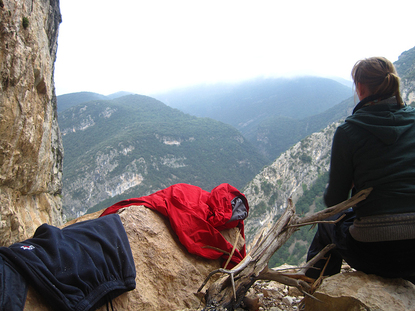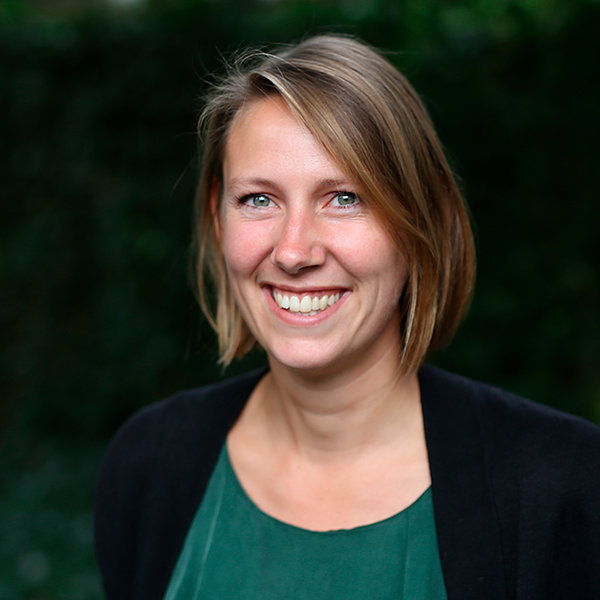
Deze pagina is niet beschikbaar in het Nederlands. - Bekijk in het Engels:
In their book Presence, learning professionals Peter Senge, Otto Scharmer, Joseph Jaworski and Betty Flowers discuss the power of doing solos in nature. A length of time spent alone in nature; an ancient ritual that rediscovered for its transformative power. In this account, Jaworski was invited to do a solo overnight, standing up and in the rain. He describes his awkwardness and frustration whilst standing there. Just when he was about to quit the endeavour, two whales flew out of the ocean - and something shifted within him. Somehow, the experience turned into a blissful and magical one.
A solo weekend in Sant Aniol
When you do a solo in the Sant Aniol Valley in the Spanish Pyrenees, you have to make do with bats, mountain goats and a distant eagle in the sky. Nevertheless, doing a solo in the Valley is a powerful experience. Active Earth Learning, co-founded by Kessels & Smit colleague Andres Roberts, facilitates a solo weekend. A three-day program in which you make space to slow down, reflect, re-energise and reconnect with yourself. The heart of the program consists of the 24-hour solo in wild nature.
Arriving in the Valley
What is it like to participate in such a weekend? The first thing we did when we landed in Spain was to drive into the Sant Aniol Valley. After a combination of activities on the first day, such as climbing, conversations about systems and worldviews on the mountaintop, a nice dinner and even a spontaneous guided meditation in a dry riverbed, we had truly arrived. In between the activities, we talked casually about our solo: would we like to choose a spot with a view, or near the river? What would we like to bring? Food? A tent? Or try to limit the distractions? These questions were easier to answer after we had a session in which we explored the question(s) we each wanted to bring into our solo. Varying from an inquiry about authenticity to trying not to have a specific question in mind for a change.
Campfires, lightning and bats..
On Saturday morning we set out for our respective solo spots. The facilitators had thought of a spot for each of us. Depending upon our wishes we went into a cave near the river or sat on top of a mountain with a view of the Valley. Nothing to distract you except building a fire. Somehow the sensation of just sitting there and staring at the (magnificent) horizon with nothing at hand does something to you. You literally change perspective. You instantly know what is important in your life and connect to your inner self: what do I really feel? Contemplating your life, the hours pass by. The night brought a totally different sensation with it. All of a sudden being in the wild was a bit scary. What was that sound over there? Are there any animals nearby? The campfire and bats flying over my head were my constant companions. The night seemed to last three nights instead of one. Daylight brought such joy, that the solo turned into a blissful experience after all. When the facilitators came to pick me up, I was a bit shaky due to the lack of food but beaming nevertheless.
Sharing stories
After a delicious celebratory meal, we shared our experiences of our 24 hours in nature and reflected in a light manner on each others stories. Everyone had a different story, but there were some patterns nevertheless. Speaking with Andres, he shares some thoughts: What you notice is a quality in reflection. People find better space to reflect on where they are, on how they are, and on what truly is important to them. There is a sense of calm but also of clarity and energy. And then we see people make real shifts in life. Often well get messages saying something happened on the mountain and then a story of movement.
The generative capacity of nature
Jaworski and his colleagues conclude that possibilities for larger change can only come from embracing many perspectives, one of the most powerful ones being direct contact with the generative capacities of nature. After experiencing the 24-hour solo, I can only agree with them and feel like starting an inquiry into how the generative capacity of nature and maybe even the Sant Aniol Valley can become an aspect of my work around change, learning and
development.
Continuing the work
How might this carry on? Andres view is as follows: I really feel we are doing something special with Active Earth - helping people find presence, connection and energy. But there is something more profound there. Gregory Bateson, one of my heroes, writes that wisdom is about understanding interrelation of a system. And to do this, we need our conscious thinking but also our unconscious knowing. To be genuinely whole and present, we must make space for this unconscious to connect. I think this is what we are doing in the valley and why such great experiences are happening there. Curious? There is only one way to find out more!
Sources
- Senge, P., Scharmer, C.O., Jaworski, J., Flowers, B.S. (2005), Presence Exploring Profound Change in People, Organizations and Society, Nicholas Brealey Publishing
- Bateson, G. (1972), Steps to an Ecology of Mind, Chicago and London: University of Chicago Press 2000 Edition
